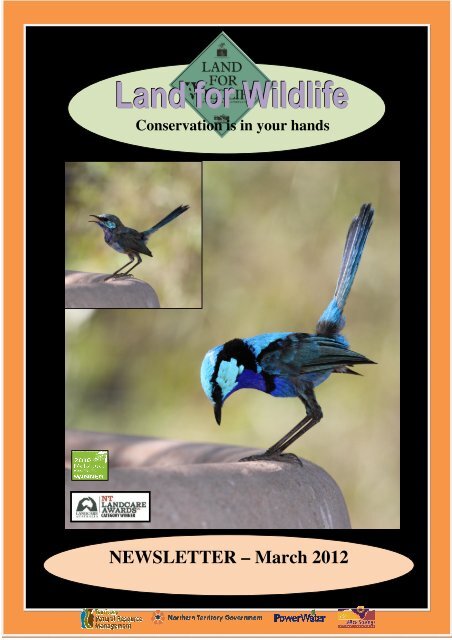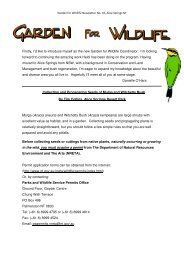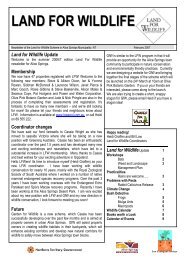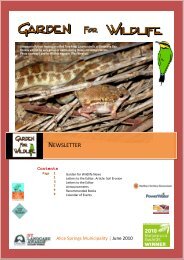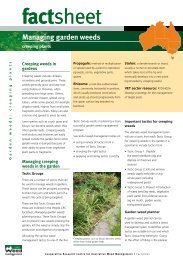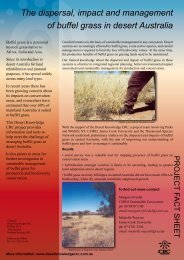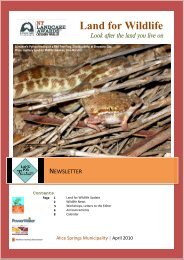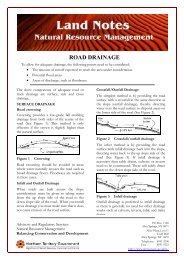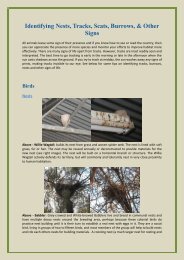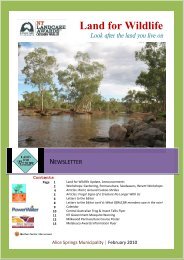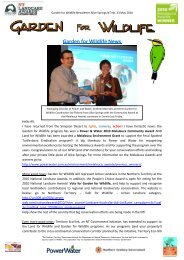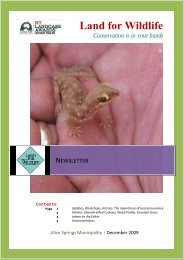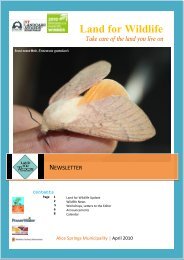LfWnewsletter_Mar2012 (PDF 8 MB) - Land for Wildlife - Low ...
LfWnewsletter_Mar2012 (PDF 8 MB) - Land for Wildlife - Low ...
LfWnewsletter_Mar2012 (PDF 8 MB) - Land for Wildlife - Low ...
- No tags were found...
Create successful ePaper yourself
Turn your PDF publications into a flip-book with our unique Google optimized e-Paper software.
Contents<strong>Land</strong> <strong>for</strong> <strong>Wildlife</strong> News ........... 2Ntaria School Welcomes <strong>Land</strong> For <strong>Wildlife</strong> ................... 2<strong>Land</strong> <strong>for</strong> <strong>Wildlife</strong> 30 th Anniversary National Conference 2Farewell to the Albrechts – <strong>Land</strong> <strong>for</strong> <strong>Wildlife</strong> stalwartsand Local Identities ....................................................... 2Articles .................................... 3Brown Snakes in Alice Springs ..................................... 3Is it a stone? Is it a shoe? No... it’s a Spotted Nightjar .. 5Pie Dish Beetle ............................................................. 7Websites Worth a Look ......... 7Recommended Books ........... 7Letters ..................................... 8Calendar of Events ................. 8On our cover this month... Splendid Fairy-wrensMalurus splendens, have just returned to the <strong>Land</strong> <strong>for</strong><strong>Wildlife</strong> birdbath after an absence of a few months. Thebeautiful male in full breeding plumage (main picture),contrasts with the inset showing a younger male who is juststarting to develop breeding colours.Photo: Chris Watson<strong>Land</strong> <strong>for</strong> <strong>Wildlife</strong> NewsNtaria School Welcomes <strong>Land</strong> For <strong>Wildlife</strong><strong>Land</strong> <strong>for</strong> <strong>Wildlife</strong> News, Alice Springs, March 2012Jesse and Chris recently returned from the nationalconference down in Melbourne. The <strong>Land</strong> <strong>for</strong> <strong>Wildlife</strong>program began in Victoria 30 years ago so it was onlyfitting that the milestone be celebrated in the place of itsbirth. Over two days we received a comprehensive roundup of <strong>Land</strong> <strong>for</strong> <strong>Wildlife</strong> in all its guises around the country.Coordinators and extension officers from every stateexcept SA were in attendance as well as many <strong>Land</strong> <strong>for</strong><strong>Wildlife</strong> property owners. Also present wererepresentatives from Birdlife Australia, the VictorianDepartment of Sustainability and Environment (DSE, and avariety of community conservation groups.When a community conservation organisation can not onlysurvive but grow and thrive over three decades the news isalways going to be positive. <strong>Land</strong> <strong>for</strong> <strong>Wildlife</strong> seems to begoing strong in all the states that it operates in, and here inThe Centre, we’re doing as well or better than most of thestates.Central Australia is the only region where <strong>Land</strong> <strong>for</strong> <strong>Wildlife</strong>is run as a not-<strong>for</strong>-profit venture under the auspices of aprivate host, rather than being a local or state Governmentorganisation. Central Australia is also distinguished inbeing the only area, other than Tasmania, that operates aGarden <strong>for</strong> <strong>Wildlife</strong> program in addition to <strong>Land</strong> <strong>for</strong> <strong>Wildlife</strong>.Our presentation was well-received and we heard plenty ofpositive feedback <strong>for</strong> the ef<strong>for</strong>ts of landholders in CentralAustralia.Also present at the conference was a small contingent fromthe Royal Forest and Bird Protection Society of NewZealand – often known simply as Forest & Bird. Thisadvance party are learning about the way <strong>Land</strong> <strong>for</strong> <strong>Wildlife</strong>operates in the different parts of Australia and will be takingthe program home to Aotearoa to start the first internationalbranch – exciting times!During February, Jesse and Chris were invited to Ntaria(Hermansburg) to talk with representatives from theTjuwampa Rangers and Ntaria School. Just <strong>for</strong> goodmeasure, we decided to take Jacelyn Anderson from theJunior Rangers program with us.Apart from a brief interruption from a Mengden’s BrownSnake Pseudonaja mengdeni (see articles), the meetingwent smoothly and resulted in at least two newmemberships, and a great new partnership.Plans are now afoot <strong>for</strong> full registration of the schoolgrounds, and repeat visits from the coordinators to assistwith workshops and biodiversity surveys in the area to helpencourage LFW programs on Aboriginal lands.<strong>Land</strong> <strong>for</strong> <strong>Wildlife</strong> 30 th Anniversary NationalConferenceOne of these representatives, Alan Fleming, will shortly bevisiting Alice Springs. If you are able to attend the rabbitcontrol workshop at Olive Pink on Saturday the 31 st ofMarch, then you will be able to meet Alan and give himyour thoughts on the <strong>Land</strong> <strong>for</strong> <strong>Wildlife</strong> program.Farewell to the Albrechts – <strong>Land</strong> <strong>for</strong><strong>Wildlife</strong> stalwarts and Local IdentitiesAfter many years in the Alice, Dave Albrecht and SallyMum<strong>for</strong>d are pulling up stumps, selling their property andheading south. Many of you would know Dave or befamiliar with his work in botanical circles around town.The Albrecht’s 20 acre bush property at White Gums wasone of the first to gain recognition as a <strong>Land</strong> <strong>for</strong> <strong>Wildlife</strong>property ten years ago. Over the past 13 years, Dave andSally have undertaken an intensive weed and vegetationmanagement program, and the property is now largelyweed free.“The Northern Territory Government through the Department of Natural Resources, Environment, the Arts and Sport is pleased to sponsor <strong>Land</strong> <strong>for</strong> <strong>Wildlife</strong>. This publication maynot represent the views of the Northern Territory Government”
As a result of this dedicated management, the propertyboasts a diverse array of local plant species and wildlifethat happily coexist with the properties infrastructure,including a mud brick home, large shed and convertedrailway carriage.Dave’s concern is that he would like the property and hishard work to continue in the care of like-minded peoplewho will continue his dedicated property and conservationmanagement.If you know of any conservation-minded people who arelooking <strong>for</strong> 20 acres of prime natural, weed-free bushland,have them get in touch with Dave. He can be contacted on8951 8791 during business hours or 8952 4571 after7:30pm.For a look at Dave’s property in more detail, have a look onthe internet,http://dl.dropbox.com/u/52938559/house%20advert.docx<strong>Land</strong> <strong>for</strong> <strong>Wildlife</strong> News, Alice Springs, March 2012are best left alone while you call the snake phone – 0407983 276. Watch the snake from a safe distance so that thesnake catcher will be able to locate it on arrival. Ifsomeone has been bitten by the snake, apply first aid (afirm pressure immobilisation bandage, splint the limb tominimise movement, and keep the patient calm and still)and call 000 immediately.For those of us who are interested in knowing what we arelooking at, the brown snakes present a real challenge.Even one of the respected authorities on Australianreptiles, Harold Cogger, has this to say about the brownsnakes in his book, Reptiles & Amphibians of Australia(Reed New Holland, 2000);“The classification of the members of this genus is in greatneed of revision. Existing species are poorly defined, andthe present classification is uncertain and unreliable.There is a high level of individual and population variabilityin colour, pattern and scalation,... Most species areprobably composite.”Farewell Dave and Sally, enjoy the winters south of Hobartand congratulations on showing us all what dedicated hardwork and good property management can produce.ArticlesWould you like to share some of your stories andexperiences of managing your property <strong>for</strong> wildlife?Maybe you’ve implemented a successful weed controlprogram or simply have some interesting wildlifehanging around?If you do, send us an email or better yet, write a shortarticle about your experiences of natural resourcemanagement in Alice Springs. We’d love somemember input into our newsletter and blog content!Brown Snakes in Alice SpringsIt’s been a fairly big year <strong>for</strong> snakes around Alice Springs.The snake catchers have reported that business has beenvery brisk around town during the warmer weather. On ourrecent visit to Ntaria we ran into a brown snake in theschool yard and there was much debate as to exactlywhich species it was. The brown snakes are a diverse,variable, and widespread genus of snakes and can bevery difficult to identify in the field, so we thought it mightbe interesting to have a closer a look at this group and seeif we can find some reliable points of identification.It’s worth noting at the start, that from a safety point ofview, the identification of large brown snakes is academic;they are all venomous and all bites would receive thesame medical treatment and the same anti-venom.Regardless of what snake you find on your property theyThe latest review of the classification of this group was byAdam Skinner from the University of Adelaide in 2005 and,though he answered many questions, especially in regardsto the Western Brown Snake complex, he also concludedthat there was much work still to be done.The major change to the classification is that the snake<strong>for</strong>merly referred to as Western Brown Snake Pseudonajanuchalis, has now been split into three species and furthersplits may be possible. The snake now referred to as theWestern Brown Snake Pseudonaja nuchalis refers to thenorthern species with its distribution limited to the Top Endand the tropical savannahs. Shield-snouted BrownSnake Pseudonaja aspidorhyncha refers to the similarspecies found through Central Australia and quite a longway south into SA. Mengden’s Brown Snake Pseudonajamengdeni overlaps with P. aspidorhyncha in CentralAustralia, extends further into WA and refers to thespecies which usually exhibits the orange-bodied, blackheadedcolour variation.Confused yet?!? Remember, this is all with the caveat thatthis group may be further divided in future reviews. Sowhen the experts throw their hands up and declareuncertainty, us amateurs have to be careful. This beingsaid though, within the current classification, we have afew pointers that we can take note of that might aid inidentification.A point of confusion which is worth clearing up be<strong>for</strong>elooking at the brown snakes in more detail, is the KingBrown Snake. In a great example of how misleadingcommon names can be, the King Brown Snake turns outto be... a black snake. All of the brown snakes are in thegenus Pseudonaja (translated as false cobra), and theblack snakes are in a separate genus, Pseudechis (false“The Northern Territory Government through the Department of Natural Resources, Environment, the Arts and Sport is pleased to sponsor <strong>Land</strong> <strong>for</strong> <strong>Wildlife</strong>. This publication maynot represent the views of the Northern Territory Government”
<strong>Land</strong> <strong>for</strong> <strong>Wildlife</strong> News, Alice Springs, March 2012adder). So the snake that many know as the King BrownPseudechis australis, actually has more in common withthe Red-bellied Black Snake Pseudechis porphyriacus ofthe south and Collett’s Snake Pseudechis colletti ofwestern Queensland.Again this is largely academic as the black snakes andbrown snakes are all venomous, but the composition oftheir venom is one of the important points of difference.Black snake venom contains a higher proportion ofmyotoxin and haemotoxin which can cause necrosisaround the site of a bite and lead to local paralysis andmuscle death. Brown snake venom contains moreneurotoxin which accounts <strong>for</strong> their higher ranking invenom toxicity scales; neurotoxins can shut down thefunctioning of the nervous system, involuntary bodysystems like breathing and circulation, and lead to death.Different anti-venoms have been developed which arespecific to the two different groups. So you can understandthat to emergency medical practitioners at least, not tomention snake bite victims, it is worth knowing thedifference. But remember immediate treatment is thesame, keep patient calm and reassured, call 000,immobilise, pressure wrap. To avoid any confusion,ophiologists introduced the new common name MulgaSnake <strong>for</strong> P. australis. This is yet to be fully adopted by thewider population and many still use the misleading “KingBrown” tag.Ringed Brown Snake Pseudonaja modesta. This onewas photographed in the car park at Uluru.Shield-snouted Brown Snake Pseudonajaaspidorhyncha, on the Plenty Highway, clearly showingthe single large rostral scale on the end of the snout.Around central Australia there are four main species ofbrown snake that you might encounter. (As always,regardless of which species you think you might havefound, all snakes are best observed and photographedfrom a safe distance.)The least dangerous, and arguably the prettiest of thebrown snakes, is the Ringed Brown Snake Pseudonajamodesta. This dainty reptile rarely exceeds 50cms in totallength and, although venomous, is not regarded asdangerous. It is found widely across Central Australia andmay be encountered in sandy or rocky habitats. It isrecorded as being nocturnal in warm weather and diurnalat other times. Its diet is mainly small reptiles like skinksand geckos.Mengden’s Brown Snake Pseudonaja mengdeni, onColonel Rose Drive in Alice Springs. This seems to be themore typical colouration of this species in Central Australiawith the dark head and textured orange body.The species which are regarded as dangerouslyvenomous are the ones which are most easy to confuse;the Eastern (or Common) and Shield-snouted BrownSnakes, Pseudonaja textilis and P. aspidorhyncharespectively. The other recent addition to the classification,Mengden’s Brown Snake Pseudonaja mengdeni, may beconfused with either of these in its juvenile colours but willusually exhibit some dark edging on the mid-body scales.These snakes exhibit a huge variability in their colours andbanded patterns from juvenile to adult and over thevarious habitats within their large and overlapping ranges.“The Northern Territory Government through the Department of Natural Resources, Environment, the Arts and Sport is pleased to sponsor <strong>Land</strong> <strong>for</strong> <strong>Wildlife</strong>. This publication maynot represent the views of the Northern Territory Government”
<strong>Land</strong> <strong>for</strong> <strong>Wildlife</strong> News, Alice Springs, March 2012Despite the difficulties presented by their outwardappearances there are still a few reliable ways to separatethe species, but they might require you to get a bit tooclose <strong>for</strong> com<strong>for</strong>t. If you were to use these marks toseparate them, it might be best to wait until you canexamine a road killed specimen or to get a goodphotograph from a safe distance and examine the pictureunder magnification.The snakes once referred to as “Western Brown” all havea rostral scale, the scale which covers the tip of the snout,which is described as “large and strap-like” and is higherthan it is broad. P. textilis has a series of rostral scalescovering the end of its snout rather than one large rostralscale.Mengden’s Brown Snake Pseudonaja mengdeni, this isthe young animal (hence the pale head colouring) that weencountered at Ntaria School.A large Eastern Brown Snake Pseudonaja textilis, nearParachilna in the Flinders Ranges SA.Another reliable indicator is the colour of the interior of themouth. The “Western” Brown Snakes have a dark blue,grey, or black interior and the Eastern Brown Snake has apink interior to the mouth.While it is inadvisable to put yourself in a situation whereyou would be close enough to observe some of thesedifferences in a live snake, they can be quite easy todistinguish in a half-decent photograph. Of course, none ofthis identification makes any difference to the first aid ortreatment of a person who has been bitten; the venom ofall brown snakes is similar and would be treated with thesame anti-venom.All pictures: Chris Watson.Is it a stone? Is it a shoe? No... it’s aSpotted NightjarMulga Snake Pseudechis australis, eating a frog. Widelyknown as the King Brown Snake, it is actually a type ofblack snake.When you’re interested in wildlife there is a special delightin finding something a bit unusual. Spotted NightjarsEurostopodus argus, are a common nocturnal bird in“The Northern Territory Government through the Department of Natural Resources, Environment, the Arts and Sport is pleased to sponsor <strong>Land</strong> <strong>for</strong> <strong>Wildlife</strong>. This publication maynot represent the views of the Northern Territory Government”
Central Australia but they can be tricky to get a good lookat.<strong>Land</strong> <strong>for</strong> <strong>Wildlife</strong> News, Alice Springs, March 2012Evolution has provided a different adaptation to enable thenightjar to catch its prey. Around the edge of their beaks,nightjars have specially modified feathers known as rictalbristles. As the bird flies through the evening air, it canopen its mouth and any insects in its path are effectivelyfunnelled down the gaping beak aided by this fringe of stiffwires.Ecologist, Holger Woyt struck the jackpot when he camehome recently to find this young bird roosting on hisdriveway. This species would normally be very wellcamouflaged sitting on the rocky red soils in the WesternMacDonnell Range, but it was very obvious on the baregravel.There are 118 species of Caprimulgi<strong>for</strong>mes worldwide;here in Australia we have 3 nightjars (Spotted, Whitethroated,and Large-tailed), 1 owlet-nightjar, and threefrogmouths (Tawny, Marbled, and Papuan) This is notcounting a few vagrant species that turn up from time totime, usually in northern Australia. Many nightjar speciesare partly migratory and move long distances with theseasons, including significant stretches over water. Prawntrawlers in the Gulf of Carpentaria occasionally reportLarge-tailed Nightjars flying powerfully over offshorewaters, and at least one Asian species (Grey Nightjar) hasbeen discovered roosting on a customs vessel nearAshmore Reef.Nightjars are a secretive group of birds which belong to anorder called the Caprimulgi<strong>for</strong>mes – literally translated asgoat-suckers – this name arose from a misinterpretation oftheir behaviour by early Europeans. Nightjars were oftenobserved to hang around in fields inhabited by livestock. Itwas thought that the birds might be lurking there to latchonto the teats of unsuspecting animals and drain their milkduring the night. This is now known to be untrue, but stillconjures a very amusing mental image! In truth, thenightjars’ fondness <strong>for</strong> livestock is probably related to theinsects attracted or disturbed by the beasts – nightjars areinsect eating experts.One of the more reliable ways to see nightjars <strong>for</strong> yourself,is to park beside a waterhole right on dusk. Nightjars canoften be seen hawking insects over the water in the fadinglight. Another common method is to find a secluded dirttrack and drive along in second gear after dark; they canoften be found roosting on the road which is why theyfrequently end up the victims of faster moving vehicles onthe highways.Nightjars are not equipped with strong feet and talons likean owl with which to catch and kill their prey. In fact, thenightjars are closely related to another group of birds, theswifts, which are in the family Apodidae – literallytranslated as; no feet. (The swifts do have feet, but suchtiny and ineffective ones that they went unnoticed <strong>for</strong> manyyears. Swifts spend the majority of their lives on the wingand manage to eat, sleep, and even copulate in flight –who needs feet if you can do all that?!).“The Northern Territory Government through the Department of Natural Resources, Environment, the Arts and Sport is pleased to sponsor <strong>Land</strong> <strong>for</strong> <strong>Wildlife</strong>. This publication maynot represent the views of the Northern Territory Government”
Previous page: Probably the more common way <strong>for</strong>visitors to the Red Centre to see a Spotted Nightjar –stuck under the windscreen wipers of a tourist coach.You’ll notice the overall darker plumage on this adultbird which lacks the pink tints of the juvenile. Alsovisible is one of the prominent white wing spots <strong>for</strong>which the bird is named.All pictures: Chris WatsonPie Dish BeetleWith a bit of rain about lately, the bugs and beetles havebeen a bit more noticeable. This beauty showed up on a<strong>Land</strong> <strong>for</strong> <strong>Wildlife</strong> doorstep in Ross earlier in the month.Commonly known as a Pie-dish Beetle Helea sp., thisarmoured beetle is about the size of a fifty cent piece.<strong>Land</strong> <strong>for</strong> <strong>Wildlife</strong> News, Alice Springs, March 2012Pictures: Chris WatsonFor more images of Pie-dish Beetles, see the cover of ourFebruary 2011 newsletter.Websites Worth a LookSTEWED THOUGHTShttp://www.stewartmacdonald.com.au/blog/2011/05/doingalice/Stewart Macdonald has an obvious passion <strong>for</strong> Australianwildlife in general and reptiles in particular. His blog is aherper’s dream. Stewart has many articles covering a hugevariety of Australian habitat, including several on AliceSprings and the surrounding region. His blog features highquality images of local reptiles, insects, and mammals anda few stories about where he travelled to find them.Recommended BooksA Field Guide to Eremophilas ofWestern AustraliaBrown, Andrew and BevanBurtchellSimon Nevill Publications, 2011.Octavo, paperback, 336 pp. colourphotographs, maps.The purpose of the edged carapace is that when the beetleis attacked by a potential predator, it tilts its entire bodytoward the attacker. It then digs the lip of the carapace intothe ground to prevent anything getting underneath andflipping it on its back.A great field guide guide with photographs and maps.Although focussing on WA, this book also covers severalNT species that are also found in the Alice Springs area.The book covers derivation of species names, floweringperiod, description, distribution and habitat, and notes.Many WA species will happily grow in Alice Springsgardens, and the book is a valuable guide <strong>for</strong> thosewishing to plant bird attracting shrubs in their backyard.Grasses of the Northern TerritorySavannahs: a Field GuideCrowder, Sam and BoroniaSaggersGreening Australia NT/NTRETAS,2010. Octavo, spirally bound, 84pp. colour photographs.“The Northern Territory Government through the Department of Natural Resources, Environment, the Arts and Sport is pleased to sponsor <strong>Land</strong> <strong>for</strong> <strong>Wildlife</strong>. This publication maynot represent the views of the Northern Territory Government”
This field guide identifies 66 grasses of the NorthernTerritory savannahs. Each species is accompanied bycolour photographs, succinct descriptions, notes on habitatand distribution as well as a grazing value guide.<strong>Land</strong> <strong>for</strong> <strong>Wildlife</strong> News, Alice Springs, March 2012as we realised it was a Whiskered Tern Chlidoniashybridus, in non-breeding plumage – note the short tail.This is still a very beautiful bird but not quite the megararitythat was initially thought.Sightings from UweLetters<strong>Land</strong> <strong>for</strong> <strong>Wildlife</strong> member Uwe Path has been finding somany new critters on his property that he almost warrantshis own section in the newsletter – “Sightings from Uwe”...A moth caterpillar...Arctic Terns have only infrequently been recorded aroundthe Australian coast and never very far inland. But younever know... keep your eyes peeled!Ripley’s Believe It or Not!Hopefully it has been long enough that copyright laws willnot be triggered by my shameless invocation of JackPalance’s breathless rasping. Newly rejoined original <strong>Land</strong><strong>for</strong> <strong>Wildlife</strong> member Sue Ripley has sent us a trulyastonishing example of natural art.Larva of the Four-spotted Cup Moth Doratiferaquadriguttata.Uwe has sent in another great photo from the ever-growingmenagerie that can be found on his property. Thiscaterpillar had us stumped initially but in the search <strong>for</strong> apositive identification, we found a very useful website.The Coffs Harbour Butterfly House website has a resource<strong>for</strong> anyone trying to identify caterpillars, moths orbutterflies. If you're ever trying to pin down the identity of acaterpillar in your yard try visitinghttp://lepidoptera.butterflyhouse.com.au/The database here is by no means exhaustive but providesa fair cross-section of the more common species that youmight come across.Sue found these Processionary Caterpillars in her backyard one evening making a very good hash of drawing aballetic emu prancing across the gravel driveway.What do you think readers? Has anyone else out there gota photograph of wildlife creating art?Calendar of EventsA mystery tern species...Uwe originally thought this might have been a vagrantArctic Tern Sterna paradisaea, in non-breeding plumage.After consultation with the <strong>Land</strong> <strong>for</strong> <strong>Wildlife</strong> Coordinators,he was able to take interstate twitchers off stand-by mode,31/3/2012<strong>Land</strong> <strong>for</strong> <strong>Wildlife</strong> Workshop:Rabbits in Central AustraliaOlive Pink Botanic Garden, 10am<strong>Land</strong> <strong>for</strong> <strong>Wildlife</strong> is about to assistlandholders to embark on a rabbit controlprogram by setting up demonstrationcontrol on several properties, a projectfunded by Territory Natural ResourceManagement. To launch the project,we’re holding an in<strong>for</strong>mation sessionwhere we will present a history of rabbitsin central Australia and shareexperiences on controlling them over thepast 30 years. This will be followed by anoverview of the current project with theopportunity <strong>for</strong> people to talk to <strong>Land</strong> <strong>for</strong>“The Northern Territory Government through the Department of Natural Resources, Environment, the Arts and Sport is pleased to sponsor <strong>Land</strong> <strong>for</strong> <strong>Wildlife</strong>. This publication maynot represent the views of the Northern Territory Government”
1/4/2012<strong>Wildlife</strong> Coordinators about how theymay be able to be involved in the project.ContactPhone: 8955 5222Email: lfw@lowecol.com.auNational Smile DayOrganisation: The Humour FoundationSmile Day is the Humour Foundation'sannual fundraising activity. The dayhelps the foundation raise funds tocontinue making sick children smile.National/State: NationalContactPhone: 02 8978 4500 or 1300 486 687Fax: 02 9982 8208Email:fundraising@humourfoundation.com.auWebsite:www.humourfoundation.com.au/Address: Suite 3.5, Level 3, 126 GrevilleStreetCHATSWOOD NSW 2067<strong>Land</strong> <strong>for</strong> <strong>Wildlife</strong> News, Alice Springs, March 201222/4/2012World Health DayOrganisation: United NationsWorld Health Day is a commemoration ofthe founding of the World HealthOrganisation. It functions as anopportunity to focus on health issues thataffect the international community.National/State: InternationalContactWebsite: www.who.int/world-healthday/en/13-15-21/4/2012Website: www.pillowfightday.com/National Youth WeekOrganisation: Joint Australian, State,Territory and Local Government initiativeNational Youth Week is an annual,weeklong celebration of young people (12to 25) throughout Australia. NationalYouth Week encourages youths to shareideas, attend events, discuss youthissues, showcase their talents and evenhave a bit of fun.National/State: NationalContactPhone: 1300 363 079Email: nationalyouthweek@deewr.gov.auWebsite:https://youthweek.com/Pages/default.aspx7/4/201222/4/2012International Creativity & InnovationWeekEach year International Creativity andInnovation Week is a celebration of newideas, imagination and anything that hasmade the world a better place.National/State: InternationalContactWebsite:www.creativityday.org/Welcome.html7/4/2012Pillow Fight DayOrganisation: The Urban PlaygroundMovementInternational Pillow Fight day is an UrbanPlayground Movement initiative. It is afree, public all-ages event, with an aim ofgetting people off the couch and out ofthe house to appreciate the fun they canhave in their cities.National/State: InternationalContactEarth DayOrganisation: Earth Day NetworkEarth Day is a celebration of theenvironment we all share. It also acts as aday of conservation awareness.National/State: International“The Northern Territory Government through the Department of Natural Resources, Environment, the Arts and Sport is pleased to sponsor <strong>Land</strong> <strong>for</strong> <strong>Wildlife</strong>. This publication maynot represent the views of the Northern Territory Government”
<strong>Land</strong> <strong>for</strong> <strong>Wildlife</strong> News, Alice Springs, March 2012ContactEmail: michelson@earthday.orgWebsite: www.earthday.org/about26/4/2012Pay it Forward DayBased on a concept from a CatherineRyan Hyde novel, Pay It Forward Dayurges people around the world to commitrandom acts of kindness. It is a day to dogood deeds, and instruct the recipient ofyour good deed to 'pay it <strong>for</strong>ward', andreturn the good deed to another person.National/State: InternationalContactPhone: (612) 9540 5150Website: payit<strong>for</strong>wardday.com/<strong>Low</strong> EcologicalServices P/LThis newsletter has been produced byJesse Carpenter, Chris Watson and Bill <strong>Low</strong>, LfWcoordinators, W.A. <strong>Low</strong> Ecological Services,Contact Jesse or Chris on 89555222 or lfw@lowecol.com.auTake care,Jesse, Chris & Bill<strong>Land</strong> <strong>for</strong> <strong>Wildlife</strong> Coordinators<strong>Land</strong> <strong>for</strong> <strong>Wildlife</strong> is sponsored by:“The Northern Territory Government through the Department of Natural Resources, Environment, the Arts and Sport is pleased to sponsor <strong>Land</strong> <strong>for</strong> <strong>Wildlife</strong>. This publication maynot represent the views of the Northern Territory Government”


